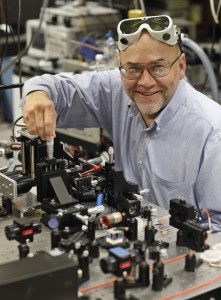
Elliott Brown, Ph.D., said the contract has resulted in the hiring of a graduate student and a postdoctoral fellow at Wright State. More importantly, he said, it will add another program element—solid-state devices--to his team’s research into terahertz radiation.
Wright State University has won a five-year, $750,000 contract from the Defense Department to explore an electronic compound semiconductor that could lead to improvements in military radar.
The contract was awarded to a Notre Dame-led university research group that includes Wright State, Ohio State and Johns Hopkins.
Physicist and engineer Elliott Brown, Ph.D., Ohio Research Scholars Endowed Chair in Sensors Physics at Wright State, said the research will focus on gallium nitride, a “wide-band-gap” semiconductor that could potentially raise the power output levels of electronic devices and sources up to terahertz frequencies.
“A good application for it is building a radio frequency power amplifier of the type that they use in radar systems,” Brown said. “The Navy, Air Force and Army all have a lot of radars; so there is a lot of interest in this application.”
Brown said the contract has resulted in the hiring of a graduate student and a postdoctoral fellow at Wright State. More importantly, he said, it will add another program element—solid-state devices–to his team’s research into terahertz radiation.
Terahertz radiation consists of invisible light waves in the electromagnetic spectrum higher in frequency than microwave and lower than infrared light. Terahertz waves can penetrate materials such as clothing, paper, cardboard, wood and plastic, but not metal or water.
Terahertz imaging has been used to inspect foam insulation on the space shuttle’s external tank, looking for cracks and bubbles. It is used in historic churches to determine whether significant artworks have been plastered over. And it is used to test semiconductors to determine if the quality is high enough to use in a computer chip.
Brown said Wright State’s role in the gallium nitride research will be measurement and diagnostics.
“We’re going to be involved in taking devices that come out of fabrication, probably at Ohio State or Notre Dame, and actually measuring the terahertz performance using novel technologies that we’ve developed here,” he said.

 Milling around
Milling around  Wright State recognizes Nursing Professor Kim Ringo for advancing international student success
Wright State recognizes Nursing Professor Kim Ringo for advancing international student success  Wright State honors graduating students for distinguished doctoral dissertations
Wright State honors graduating students for distinguished doctoral dissertations  Top 10 Newsroom videos of 2025
Top 10 Newsroom videos of 2025  Museum-quality replica of historic Hawthorn Hill donated to Wright State
Museum-quality replica of historic Hawthorn Hill donated to Wright State 